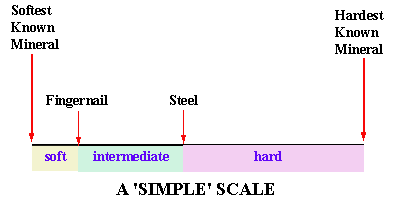CALCULATING A 'HARDNESS VALUE'
The hardness of a geologic material depends upon the hardness of the minerals of which it is composed. If the hardnesses of the individual minerals and the percentages of those minerals are known, a "hardness value" (HV) for the material as a whole may be calculated (see example):
- Print out a copy of the 'Hardness Value Calculation Table' (printout # Q-3).

- Enter the name of the Material (e.g., SCHIST) at the top of the Table.
- Enter the percentages of the minerals out of which it is made in the 'Mineral Percent' column. (Obtain these percentages from your 'Mineral Composition Tabulation Sheet', printout # Q-1).
- Enter the hardness of each of the minerals in the 'Mineral Hardness' column. Express the hardness as 'hard', 'intermediate', or 'soft'. (Obtain the hardness from your printout of the 'NY City Minerals - Record of Hardness' Form', printout # Q-2).
- For each mineral, enter the numerical equivalent (N.E.) of its hardness in the 'Numerical Equivalent' column: 1 for soft; 3 for intermediate; 7 for hard.
- For each mineral, multiply (%M) times (N.E.) and enter the result in the (%M x N.E.) column.
- Add together all the results of step (7) and enter the sum in the TOTAL box.
- Divide the value in the TOTAL box by 100. Round off the result to two decimal places and enter it in the HARDNESS VALUE box.
|  |